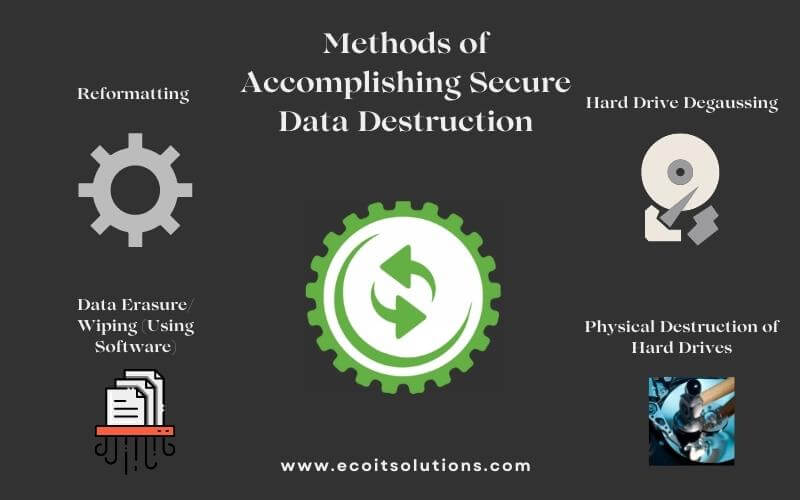Finest Practices for Data Destruction to Strengthen Your Cyber Security Framework
Finest Practices for Data Destruction to Strengthen Your Cyber Security Framework
Blog Article
The Value of Effective Information Devastation Practices in Shielding Sensitive Details and Ensuring Computer System Safety And Security
In an era where information breaches are increasingly usual, the significance of effective information damage techniques can not be overemphasized. Executing durable data devastation techniques not only alleviates these risks yet likewise aligns with lawful compliance needs, guaranteeing that companies maintain their credibility and foster customer depend on.
Understanding Information Destruction
Recognizing data damage is essential in today's electronic landscape, where sensitive info can conveniently be jeopardized. Reliable data damage entails not simply removing files yet ensuring that information is irretrievable via comprehensive techniques. This procedure is vital for companies that take care of confidential customer information, copyright, or interior papers, as any breach can bring about extreme economic and reputational effects.
Information devastation encompasses various techniques, including shredding physical media, degaussing magnetic storage space gadgets, and employing software-based options that overwrite information numerous times. Each approach serves a specific function and has to align with the sensitivity of the information being dealt with. As an example, physical destruction is often liked for tough drives containing extremely private information, while software techniques might be sufficient for much less delicate information.
Furthermore, sticking to industry standards and laws, such as the General Data Security Regulation (GDPR) or the Health And Wellness Insurance Policy Portability and Responsibility Act (HIPAA), is imperative for compliance and to minimize legal risks. Organizations has to establish a durable information damage policy, train staff members on finest practices, and frequently audit their treatments to make sure that all sensitive information is dealt with safely and effectively.
Dangers of Inadequate Practices
Inadequate information devastation techniques subject companies to substantial threats that can have significant repercussions. When delicate information is not correctly gotten rid of, it continues to be vulnerable to unauthorized access, which can bring about information breaches and identity burglary. Such events not just jeopardize the safety of individuals but likewise stain the organization's track record, leading to a loss of customer trust fund and prospective economic repercussions.
In addition, governing conformity is significantly rigorous in lots of industries. Failure to abide by information damage regulations can cause substantial fines and lawsuits against organizations. These penalties can divert and stress financial sources attention from core business operations.
On top of that, the misuse of recurring information can lead to copyright theft or corporate espionage, jeopardizing competitive advantages (data destruction). The impact of inadequate information damage prolongs beyond prompt financial losses; it can additionally result in long-term damages to brand name integrity and market position

Organizations should identify that information safety is not only regarding preventing violations; it additionally encompasses the liable administration of data throughout its lifecycle. Disregarding effective information destruction protocols can have catastrophic effects, underscoring the necessity for durable actions to mitigate these risks.
Best Practices for Information Damage
Executing efficient data damage practices is vital for securing delicate information and keeping compliance with regulatory criteria. Organizations needs to embrace a multi-faceted method to ensure that information is irretrievable, consequently avoiding unauthorized accessibility and prospective breaches.
First, information ought to be categorized based upon sensitivity, permitting companies to apply ideal damage methods customized to the level of risk. For digital information, utilizing software-based data-wiping devices that abide by market standards can properly overwrite existing data. Physical destruction techniques, such as shredding or degaussing, are essential for tools that keep delicate information, making certain total eradication.
Establishing a clear information retention policy is essential, detailing the length of time different kinds of information need to be kept prior to destruction. Normal audits of information storage space systems are also needed to recognize out-of-date or unneeded data requiring elimination.
Furthermore, training employees on the value of data damage and the specific methods to comply with fosters a society of safety within the organization. Ultimately, keeping documents of information destruction refines provides responsibility and sustains compliance with inner plans and exterior policies. By adhering to these ideal techniques, organizations can significantly minimize the dangers related to data direct exposure.
Legal and Compliance Considerations

Failing to conform with these visit here regulations can lead to serious charges, including significant penalties and reputational damage. Organizations needs to implement a durable data devastation plan that lines up with these legal frameworks and provides clear guidelines on the proper techniques of data disposal, whether physical shredding or electronic wiping.
In addition, maintaining documentation of information devastation tasks is vital for showing conformity throughout audits or evaluations. By prioritizing legal and compliance considerations, companies can boost their information safety posture and foster trust fund with stakeholders and customers, eventually contributing to a much more safe and secure information monitoring atmosphere.
Advantages of Effective Data Damage
Effective information damage practices expand past plain compliance; they supply substantial advantages to organizations that prioritize them. By making certain that delicate info is irretrievably destroyed, companies alleviate the threat of data violations and the possible economic effects connected with them. This proactive technique not only safeguards versus unauthorized gain access to but also improves the overall trustworthiness of the company in the eyes of stakeholders and customers.
Implementing robust data damage methods, such as physical devastation of storage gadgets or sophisticated data cleaning methods, adds to the fortifying of a company's cybersecurity pose. data destruction. It lowers the chance of copyright burglary and safeguards proprietary details, thereby maintaining an one-upmanship in the market

Verdict
In verdict, effective information damage practices are necessary for protecting delicate info internet and enhancing total computer system safety. Eventually, a commitment to durable data destruction approaches promotes a culture of duty, consequently strengthening a company's cybersecurity pose and maintaining customer count on.

Report this page